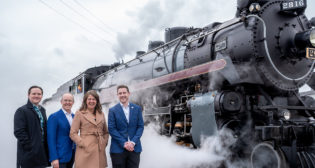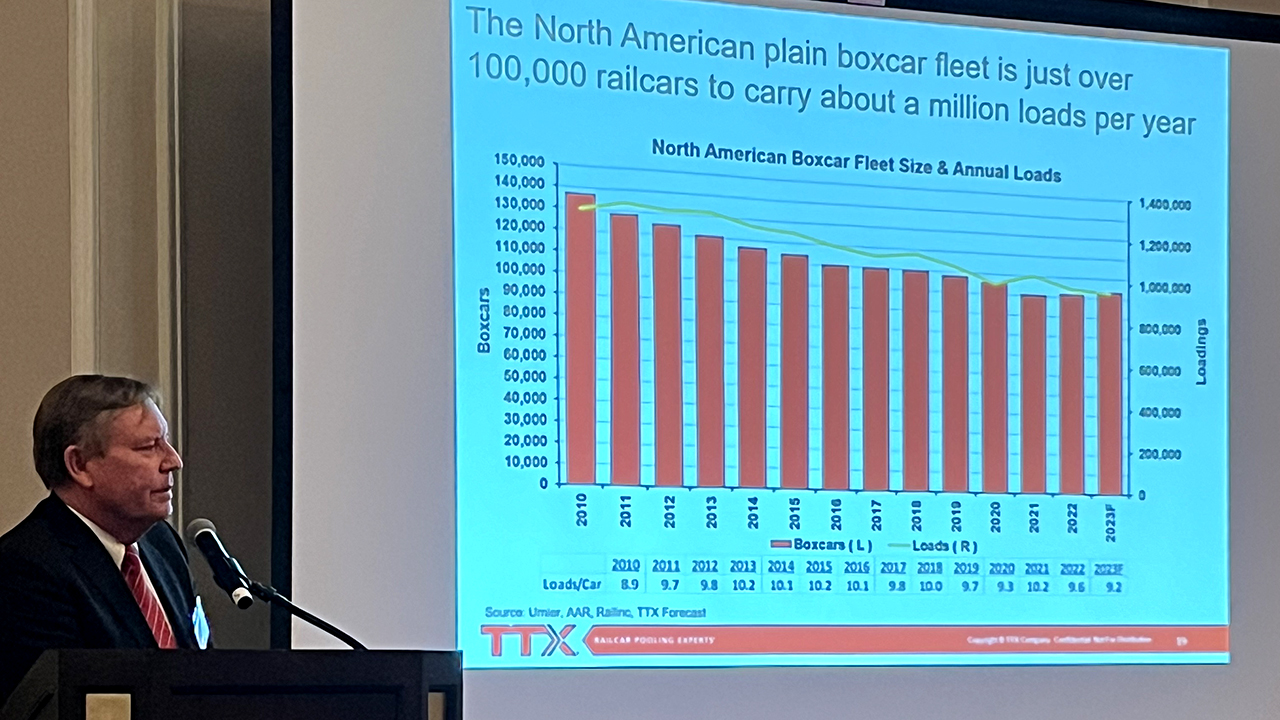
TTX’s Tom Wells on Driving Down Railcar Maintenance Costs
Written by Ron Sucik, Contributing Editor and Principal, RSE Consulting
TTX President and CEO Tom Wells. Ron Sucik photo.
Despite the below-freezing inclement weather, a respectable number of hearty Midwest railroaders gathered at the Union League Club of Chicago to attend the January meeting of the Western Railway Club. Following tradition, TTX Company was asked to make a presentation on its current status.
President and CEO Tom Wells presented a current review of TTX and its role in the rail industry. He focused on the current boxcar situation and presented a brief history of AEI and the transition into new technology, specifically the telematics product TTX is using.
Although most in the room were familiar with TTX, Wells gave a good review of the freight car pooling aspect of TTX for the benefit of attendees who are new to the industry. Pooling a fleet of cars for the railroads is capital-affordable, lowering the cost otherwise necessary for repositioning of empty equipment miles, and shares the use risk of a 50-year product life span changing or becoming obsolete, Wells noted. TTX also specializes in a railcar’s complete repair and maintenance cycle. Maintenance includes historical repair data and not waiting for a failure. This maintenance, and timely wheelset changeouts, create more than $100 million of value annually. The resulting decrease in out-of-service time otherwise lost during an operational failure increases reliability, making the railroads more competitive in the transportation environment.
The transition to standardized boxcar sizes and the use of pooling over the past five years has resulted in an increase to 10.8 loadings per year, compared to 9.0 loadings previously, Wells said. Minimizing of empty miles has also made it possible to reduce the size of the North American boxcar fleet, lowering total railroad maintenance costs.
Wells gave a brief history of how railroads track equipment location and movements. Her went back to the 1960’s implementation AEI’s precursor, illustrating what an AEI placard often looks like after many service years during a railcar’s lifetime. This was a segue into the railroads’ gradual evolution toward telematics for equipment tracking. TTX is one of the groups transitioning to this new technology. Low-altitude satellites and GPS tracking offer a significant improvement, leading to continued cost savings for the rail industry.
Wells closed his presentation with TTX’s relocation to Charlotte, N.C. in June 2024. Of the company’s 1,900-plus employees, 90% are relocating.
As Director, Market Development at TTX, Ron Sucik established relationships in the industry that include members of the railroads, steamship lines, port authorities, transloaders, 3PLs, motor carriers, intermodal marketing companies, retail industry and real estate development companies. Ron is recognized as having a significant understanding of the trends of trade flows into North America and the affect they have on the rail industry. He is often called upon for his perspective of emerging issues. Ron’s prior experience at Burlington Northern gave him an understanding of the basic operational aspects of the rail side of the intermodal industry as well. He holds a Bachelor of Science in Business Administration and an MBA with emphasis on Marketing from Illinois Benedictine University. Ron remains active within the transportation community as a consultant. He was a major contributor to the CIGMA International Freight Study at the Tioga Group, and continues to make presentations on the issues and trends in the intermodal industry.



